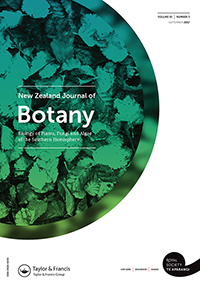Ver ítem
- xmlui.general.dspace_homeCentros Regionales y EEAsCentro Regional Patagonia NorteEEA BarilocheArtículos científicosxmlui.ArtifactBrowser.ItemViewer.trail
- Inicio
- Centros Regionales y EEAs
- Centro Regional Patagonia Norte
- EEA Bariloche
- Artículos científicos
- Ver ítem
Characterisation and transferability of transcriptomic microsatellite markers for Nothofagus species
Resumen
Discriminant molecular markers are required for research on population genetics, as well as evolutionary studies involving identification of hybrids and parental species, or detection of the genome regions under selection. We provide a set of 27 transcriptomic microsatellite markers (SSRs) for South American Nothofagus species, derived from 73 Nothofagus alpina (=N. nervosa) annotated unigenes. Rates of cross-amplification ranged from 22% to 37%. Genetic
[ver mas...]
Discriminant molecular markers are required for research on population genetics, as well as evolutionary studies involving identification of hybrids and parental species, or detection of the genome regions under selection. We provide a set of 27 transcriptomic microsatellite markers (SSRs) for South American Nothofagus species, derived from 73 Nothofagus alpina (=N. nervosa) annotated unigenes. Rates of cross-amplification ranged from 22% to 37%. Genetic characterisation of 22 transcriptomic SSRs for N. alpina and N. obliqua reveals low genetic variability, due to the general occurrence of one major allele at each locus, and high specificity, with few alleles shared between species (14%). At inter-species level 95% of loci were discriminant, with a total G’’st over loci of 0.9, indicating that
alleles were mostly fixed for all loci in both species. At intraspecies level the number of markers with significant differentiation was 2.5 times higher for N. obliqua than for N. alpina populations. Moreover, transcriptomic SSRs showed
higher performance compared with published anonymous microsatellites isolated from genome sequences without annotation. This set of transcriptomic microsatellites will be useful to the scientific community working on conservation and evolutionary aspects of Nothofagus species.
[Cerrar]

Fuente
New Zealand journal of botany 55 (3) : 1-10. (2017)
Fecha
2017-07
ISSN
0028-825X (Print)
1175-8643 (Online)
1175-8643 (Online)
Formato
pdf
Tipo de documento
article
Palabras Claves
Derechos de acceso
Restringido
 Excepto donde se diga explicitamente, este item se publica bajo la siguiente descripción: Creative Commons Attribution-NonCommercial-ShareAlike 2.5 Unported (CC BY-NC-SA 2.5)
Excepto donde se diga explicitamente, este item se publica bajo la siguiente descripción: Creative Commons Attribution-NonCommercial-ShareAlike 2.5 Unported (CC BY-NC-SA 2.5)

